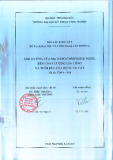
RESEARCH Open Access
LgR5 expression and cancer stem cell
hypothesis: clue to define the true origin
of esophageal adenocarcinomas with and
without Barrett’sEsophagus?
Burkhard HA von Rahden
1*
, Stefan Kircher
2
, Maria Lazariotou
3
, Christoph Reiber
1
, Luisa Stuermer
1
, Christoph Otto
1
,
Christoph T Germer
1
, Martin Grimm
1
Abstract
Background: Investigation of the expression of an intestinal stem cell marker in esophageal adenocarcinomas
(EAC) with and without Barrett’s Esophagus (BE), with respect to a cancer stem cell (CSC) hypothesis.
Materials and methods: Expression of a putative intestinal stem cell marker LgR5 was analyzed in esophageal
cancer specimen (n = 70: 41 EAC with BE, 19 EAC without BE, and n = 10 esophageal squamous-cell carcinomas,
ESCC) and in the adenocarcinoma cell line OE-33. Ki-67 and Cdx-2 were co-labelled with LgR5 in double staining
experiments. Immunhistochemical expression results were confirmed by RT-PCR and correlated with tumor stage
and five-year survival rates.
Results: LgR5was found expressed in 35 of 41 (85%) EAC with BE and in 16 of 19 (81%) EAC without BE. By
contrast, LgR5 was not found to be expressed in ESCC. Quantification of immunolabeling showed 15% LgR5+ cells
in EAC with BE, 32% LgR5+ cells in adjacent BE and 13% in EAC without BE. Immunofluorescence double staining
experiments with LgR5 and Ki-67 revealed a subpopulation (~5%) of proliferating LgR+/Ki-67+ cells. On mRNA-
level, expression of LgR5 was higher in BE in comparison to EAC (p = 0.0159). High levels of LgR5 expression in BE
associated EAC were associated with poorer survival in univariate analysis.
Conclusion: The stem cell marker LgR5 is expressed in EAC, irrespective of association with BE, and appears to
have negative impact on survival. The subset of proliferating LgR5+ cells (<5%) might resemble rapidly cycling
CSCs, which needs to be substantiated in further investigations.
Introduction
Esophageal adenocarcinoma (EAC) is an entity of
increasing clinical importance, due to an unexplained
incidenceriseamongwhitemalesintheWesternworld
[1], and a dismal prognosis [2,3]. Chances for cure are
still limited to early, surgically resectable tumor stages,
prior to systemic dissemination of the disease. EACs
develop almost exclusively in the distal third of the eso-
phagus, under the chronically damaging effect of gastroe-
sophageal reflux [2,3]. Barrett’s esophagus (BE) - defined
as columnar-lined epithelium in the distal esophagus,
characterized by specialized intestinal mucosa (with gob-
let cells) - is regarded as a precancerous lesion, giving
rise to these tumors.
Malignant progression within BE is regarded to follow
a sequence of well-characterized histopathologic changes,
from intestinal metaplasia,overlow-gradeandhigh-
grade dysplasia/intraepithelial neoplasia towards invasive
adenocarcinomas [2,3]. However, not all esophageal ade-
nocarcinomas are associated with BE in surgical series
[4,5], and only a minority of patients with BE progress to
cancer, with an incidence of 0.5% per year [6]. These and
other findings have raised doubt about the relevance of
BE as precancerous lesion of EACs (e.g. [7]), stimulation
* Correspondence: Rahden_B@chirurgie.uni-wuerzburg.de
1
Department of General-, Visceral-, Vascular and Pediatric Surgery, University
Hospital Wuerzburg, Oberduerrbacher Strasse 6, 97080 Wuerzburg, Germany
Full list of author information is available at the end of the article
von Rahden et al.Journal of Experimental & Clinical Cancer Research 2011, 30:23
http://www.jeccr.com/content/30/1/23
© 2011 von Rahden et al; licensee BioMed Central Ltd. This is an Open Access article distributed under the terms of the Creative
Commons Attribution License (http://creativecommons.org/licenses/by/2.0), which permits unrestricted use, distribution, and
reproduction in any medium, provided the original work is properly cited.

the search for the cell population, from which EACs ori-
ginate and which is currently unknown.
Two cancer models have been put forward to explain
tumor heterogeneity and inherent differences of tumor-
regenerating capacity [8]. The clonal selection model of
carcinogenesis implies that a random solitary cell under-
goes malignant transformation, accumulates multiple
mutations and subsequently acquires a survival advan-
tage, which leads to clonal selection [9,10]. In contrast,
the cancer stem cell (CSC) hypothesis regards malignant
transformation as a process, occurring in a subset of
normal stem cells with pluripotent properties, which
underlie deregulation of self-renewal pathways [11,12].
Evidence is accumulating that most, if not all, malig-
nancies are driven by a cancer stem cell compartment
[8]. The existence of cancer stem cells would explain
why only a small minority of cancer cells is capable of
extensive proliferation within the tumor. Furthermore,
these cancer stem cells may be inherently resistant to
our current therapeutic approaches. It is important to
note that the two models are not mutually exclusive, as
CSCs themselves may undergo clonal evolution, as
already shown for leukaemia cells [13,14].
A stem cell hypothesis for BE has also been put for-
ward by the group around Spechler [13]. It has been
proposed that specialized intestinal metaplasia could
arise from a change in the differentiation pattern of
stem cells that might either reside in the esophagus or
which might be recruited to the esophagus from the
bone marrow [13]. A putative intestinal stem cell mar-
ker has been proposed to be potentially implicated in
carcinogenesis of BE and EAC, but have so far not been
thoroughly investigated. Leucine-rich-repeat-containing
G-protein-coupled receptor (LgR5) has been shown to be
associated with intestinal stem cell properties [15-18].
The aim of our study was to investigate expression of
this putative intestinal stem cell marker in esophageal
adenocarcinomas (EAC) with and without associated
intestinal metaplasia (BE) as well as associated BE and
squamous cell carcinomas. We aimed to give an indica-
tion for the carcinogenic process of EACs with respect
to a cancer stem cell (CSC) hypothesis.
Materials and methods
Patients and Tumor Specimen
Surgical specimen from altogether 70 patients having
undergone primary surgical resection for esophageal
cancer between January 2001 and June 2004 with com-
plete (R0) resection, were included in our study. Patients
with preoperative antineoplastic therapies (chemoradia-
tion/chemotherapy) were excluded.
The material was archival formalin-fixed, paraffin-
embedded tissue from routine histopathologic work-up.
Formalin-fixation and paraffin-embedding had been
performed under standardized conditions. The material
had been stored with permission of the local ethics
committee, after informed consent obtained from the
patients prior to surgical resection.
There were n = 41 esophageal adenocarcinomas (EAC)
with associated Barrett’sesophagus(BE),n=19EAC
without BE and n = 10 esophageal squamous-cell carci-
nomas (ESCC) of the esophagus (which were included as
negative controls). EAC without BE was defined based on
clinical information (endoscopic evidence of Barrett’s
mucosa), work-up of all tumor blocks (specialized intest-
inal metaplasia) and Cdx-2 staining which is regarded to
have a 70% sensitivity [19]. Of note, EAC were tumors in
the distal esophagus (AEG type I tumors, according to
the classification by Siewert and Stein, 1998, Br J Surg
[20]), and explicitly not localized at the level of the ana-
tomic gastric cardia (AEG type II tumors). The AEG type
II adenocarcinoma is a tumor entity on its own and must
be discussed differently.
Follow-up data were obtained from our local tumor
registry of Lower Frankonia/Germany and was complete
(100%) for all patients. In this tumor registry, data are
stored also with permission obtained from the patients
and due to the regulation of the local ethics committee.
Mean follow-up was 29 months ± 17.6 standard devia-
tion. Tumor and patient characteristics are summarized
in Table 1 and 2.
Histopathologic Analysis, Tumor Staging and Definition of
Barrett’s mucosa
Tumor blocks of paraffin-embedded tissue were selected
by two experienced gastrointestinal pathologists (Stefan
Kircher, Stefan Gattenlöhner), evaluating the routine H.
E. stained sections. Sections from all available tumors
underwent intensive histopathologic assessment, blinded
to the prior histopathology report. H.E. stained sections
were analyzed with respect to tumor infiltrated areas
(EAC/ESCC), stromal areas and infiltrating immune
cells. Tumor staging was performed according to the 6
th
edition of the TNM staging system by the UICC/AJCC
of 2002 [21]. Grading was performed according to
WHO criteria [22]. Tumor characteristics (UICC stage,
pT-categories, pN-categories, cM-categories, number of
removed lymph nodes, number of tumor infiltrated
lymph nodes, residual tumor status, localization) and
patient characteristics were collected in a database
(EXCEL, Microsoft).
Barrett’s muscosa was defined as specialized intestinal
metaplasia, with goblet cells [2,3]. In addition, immuno-
histochemistry with Caudal type homeobox transcription
factor 2 (Cdx-2), which is suggested as early marker for
intestinal metaplasia [23] with a known sensitivity of
70%[19],wasusedtoidentifytinyfociofintestinal
metaplasia. Furthermore, different degrees of high-grade
von Rahden et al.Journal of Experimental & Clinical Cancer Research 2011, 30:23
http://www.jeccr.com/content/30/1/23
Page 2 of 11

and low-grade intraepithelial neoplasia within Barrett’s
mucosa were assessed. EAC were classified as “EAC
with BE”, when at least tiny foci of intestinal metaplasia
were found due to Cdx-2 staining. EAC were classified
as “EAC without BE”, when the pathologists could not
find intestinal metaplasia on any of the tumor blocks.
Immunohistochemical and immunofluorescence staining
Staining for LgR5, Cdx-2, and Ki-67 was performed on
serial sections of 2 μm thickness. Tissue sections were
cut from formalin-fixed paraffin-embedded (FFPE)
blocks on a microtome and mounted on adhesive
microscope slides (Hartenstein, Wuerzburg, Germany).
For immunohistochemistry, unconjugated polyclonal
LgR5 (rabbit), and isotype control antibodies (mouse,
rabbit) were purchased from Abcam (Cambrige, UK).
The unconjugated mouse monoclonal Cdx-2 antibody
was obtained from Biogenex (San Ramon, USA) and the
unconjugated mouse monoclonal Ki-67 antibody was
purchased from Acris (Hiddenhausen, Germany). The
secondary antibody used for immunofluorescence double
staining of Ki-67 was a fluoresceinisothiocyanat (FITC)-
conjugated AffiniPure donkey-anti-mouse IgG, used at
1:200 dilution (Jackson ImmunoResearch Laboratories
Inc., Suffolk, England). The secondary antibody for LgR5
was a Cy3-conjugated AffiniPure donkey-anti-rabbit IgG
(Jackson ImmunoResearch), used at 1:200 dilution.
Normal colon tissue was used as positive control for
LgR5 expression [24,25]. The colon tissue had undergone
the same processing, like the esophageal cancer specimen
(normal formalin-fixed, paraffin-embedded tissue from
colon resections for benign conditions - normal colon
mucosa adjacent to polyps or diverticular disease).
Cell Culture
We analyzed LgR5 expression in cells (1 × 10
4
)fromthe
esophageal adenocarcinoma cell line OE-33 (Sigma-
Aldrich, Steinheim, Germany) in cytospins as additional
positive control for LgR5 expression. This cell line is the
only commercially available adenocarcinoma cell line of
the lower esophagus (Barrett’s metaplasia) and was estab-
lished from a 73-year-old female patient. The tumor was
identified as pathological stage IIA (UICC) and showed
poor differentiation. Using RT-PCR we tested negative
Table 1 Clinicopathological characteristics of the EAC study population with BE
Characteristics Patients
(n = 41)
LgR5
Barrett’s esophagus*
p-value LgR5
Barrett’s EAC
p-value
low high low high
Age (y) .100 .051
<66 21 (51%) 10 (48%) 11 (52%) 4 (19%) 17 (81%)
≥66 20 (49%) 4 (20%) 16 (80%) 10 (50%) 10 (50%)
Gender .074 .673
Male 34 (83%) 14 (41%) 20 (59%) 11 (32%) 23 (68%)
Female 7 (17%) 0 (0%) 7 (100%) 3 (43%) 4 (57%)
Histological Grading .305
a
.083
a
G1 11 (27%) 6 (55%) 5 (45%) 6 (55%) 5 (45%)
G2 16 (39%) 5 (31%) 11 (69%) 6 (37%) 10 (63%)
G3/4 14(34%) 3 (21%) 11 (79%) 2 (14%) 12 (86%)
Depth of invasion .481
b
.155
b
pT1 10 (24%) 4 (40%) 6 (60%) 6 (60%) 4 (40%)
pT2 18 (44%) 7 (39%) 11 (61%) 6 (33%) 12 (67%)
pT3 6 (15%) 1 (17%) 5 (83%) 1 (17%) 5 (83%)
pT4 7 (17%) 2 (28%) 5 (72%) 1 (14%) 6 (86%)
Lymph node metastases .001 .0154
pN0 15 (37%) 10 (67%) 5 (33%) 9 (60%) 6 (40%)
pN1-3 26 (63%) 4 (15%) 22 (85%) 5 (19%) 21 (81%)
UICC stage .481
c
.155
c
UICC I 9 (22%) 4 (44%) 5 (56%) 2 (22%) 4 (78%)
UICC II 19 (46%) 7 (37%) 12 (63%) 7 (37%) 12 (63%)
UICC III 13 (31%) 3 (23%) 10 (77%) 5 (15%) 11 (85%)
UICC IV 0 (0%) 0 (0%) 0 (0%) 0 (0%) 0 (0%)
Median OS (m) 42 m 32 (n = 14) 24 (n = 27) 33 (n = 14) 28 (n = 27)
Abbrevations: EAC, esophageal adenocarcinomas; BE, Barrett metaplasia; y, years; G, grading; UICC, International Union against Cancer; R, residual tumor; OS,
overall survival; m, months. *Clinico-pathological features of BE are related to adjacent EAC.
a
G1/2 vs. GT3/4;
b
pT1/2 vs. pT3/4;
c
UICC I/II vs. UICC III/IV.
von Rahden et al.Journal of Experimental & Clinical Cancer Research 2011, 30:23
http://www.jeccr.com/content/30/1/23
Page 3 of 11

for mycoplasma contamination of this cell line that was
provided to our laboratory in December 2009 by Sigma.
The cell line was cultured in RPMI-1640 medium, sup-
plemented with 10% Fetal Bovine Serum, 100 units/ml of
penicillin and 100 μg/ml of streptomycin. Cytospins of
the OE-33 cell line were fixed in acetone and dried for
10 minutes. Rehydration, blocking, and the staining pro-
cedure steps were the same as described for immunohis-
tochemistry of FFPE sections. Additionally, RT-PCR was
performed for LgR5 gene expression of OE-33 cells.
Double Staining Experiments (IF and IHC)
The sequential immunofluorescence (IF) double staining
(co-expression) was analyzed for LgR5 with Ki-67
expression. Sequential immunohistochemical (IHC) dou-
ble staining was performed for Cdx-2 and LgR5.
Processing of tissue and staining procedure
Serial tissue sections (2 μm thickness) were cut from
formalin-fixed paraffin-embedded (FFPE) blocks on a
microtome and mounted from warm water onto adhe-
sive microscope slides (Hartenstein, Wuerzburg,
Germany). Sections were deparaffinized in xylene and
ethanol and rehydrated in water. Heat induced epitope
retrieval (HIER) was performed with citrate buffer pH
6.0 (Dako, Hamburg, Germany). For immunofluores-
cence, slides were incubated in normal serum (2%) and
bovine serum albumin (BSA 0.5%) at room temperature
for 20 minutes to block non-specific binding. Subse-
quently, slides were incubated with the primary antibody
or control antibody overnight at 4°C in a humidified
chamber and with secondary FITC-conjugated antibody
for 30 minutes at room temperature. Slides were subse-
quently incubated with the second primary antibody
diluted in TBS plus 0.5% BSA overnight at 4°C in a
humidified chamber followed by incubation with sec-
ondary Cy3-conjugated antibody for 30 minutes at room
temperature in a humidified chamber. Slides were coun-
terstained with DAPI (4’,6-Diamidino-2-phenylindoldi-
hydrochlorid) (Sigma-Aldrich) and covered with
Polyvinyl-alcohol mounting medium (DABCO) (Sigma-
Aldrich) and analyzed using a Zeiss camera (Jena,
Germany). The photographed images - using the Meta-
morph software package (Visitron Systems, Puchheim,
Germany) - were imported into the Microsoft Office
Picture Manager.
For immunohistochemistry, the pretreatment proce-
dure (fixation, deparaffinization, rehydration, HIER, and
blocking) of the slides was the same as described for
immunofluorescence. Endogenous peroxidase activity
was quenched with 3% hydrogen peroxide. Endogenous
biotin activity was blocked using the avidin/biotin block-
ing kit (Vector Laboratories, Burlingame, CA, USA).
Slides were then incubated with the primary antibody
alone (LgR5, Cdx-2, and Ki-67) or with pre-incubated
(30 minutes) LgR5 blocking peptide (Abgent, San Diego,
CA, USA) and LgR5 antibody. After incubation with the
primary antibody the DAKO LSAB2 System, peroxidase,
was used. Slides were subsequently incubated for
5 minutes in DAB (3,3’-diaminobenzidine) (Biogenex)
counterstained with hemalaun and mounted with
Glycergel (Dako). For immunohistochemical double
staining, we first used an alkaline phosphatase (AP)-con-
jugatedAffiniPureDonkeyanti-mouseAbfollowedby
20 minutes of incubation with Fast Red (Dako). After
incubation with the second primary antibody, we used a
horseradish peroxidase (HRP)-conjugated AffiniPure
Donkey anti-rabbit IgG (Jackson ImmunoResearch) fol-
lowed by 5 minutes of incubation with DAB (Biogenex).
Cytospins were fixed in acetone and dried for 10 min-
utes. Rehydration, blocking, and the staining procedure
was the same as described for immunohistochemistry of
FFPE sections.
Table 2 Clinicopathological characteristics of the EAC
study population (with and without BE)
Characteristics Patients
(n = 60)
LgR5
EAC
p-value
low high
Age (y) .069
<66 30 (50%) 10 (33%) 20 (67%)
≥66 30 (50%) 18 (60%) 12 (40%)
Gender 1.00
Male 52 (87%) 24 (46%) 28 (34%)
Female 8 (13%) 4 (50%) 4 (50%)
Histological classification .577
a
G1 17 (28%) 11 (65%) 6 (35%)
G2 22 (37%) 11 (50%) 11 (50%)
G3/4 21 (33%) 6 (29%) 15 (71%)
Depth of invasion .259
b
pT1 16 (27%) 11 (69%) 5 (31%)
pT2 26 (43%) 11 (42%) 15 (58%)
pT3 10 (17%) 4 (40%) 6 (60%)
pT4 8 (13%) 2 (25%) 6 (75%)
Lymph nodes metastasis .007
pN0 23 (38%) 16 (70%) 7 (30%)
pN1-3 37 (62%) 12 (32%) 25 (68%)
UICC stage .573
c
UICC I 14 (23%) 10 (71%) 4 (29%)
UICC II 28 (47%) 11 (39%) 17 (61%)
UICC III 18 (30%) 7 (39%) 11 (61%)
UICC IV 0 (0%) 0 (0%) 0 (0%)
Median OS (m) 43 m 32 (n = 28) 24 (n = 32)
Abbrevations: EAC, esophageal adenocarcinomas; BE, Barrett metaplasia; y,
years; G, grading; UICC, International Union against Cancer; R, residual tumor;
OS, overall survival; m, months.
a
G1/2 vs. GT3/4;
b
pT1/2 vs. pT3/4;
c
UICC I/II vs. UICC III/IV.
von Rahden et al.Journal of Experimental & Clinical Cancer Research 2011, 30:23
http://www.jeccr.com/content/30/1/23
Page 4 of 11

Quantification of Immunohistochemistry and
Immunofluorescence
LgR5 and Ki-67 IHC was quantified in EAC with BE, in
the associated Barrett’s mucosa, as well as EAC without
BE. Quantification of immunoenzymatic staining of
intestinal metaplasia or tumor cells was performed ana-
lyzing six defined representative individual high power
fields (× 400) for each staining sample. Scoring was
done by means of cell counting. The results were
expressed as percentages (number of positive cells
within 100 counted tumor cells, %). Sections were evalu-
ated by two independent blinded investigators separately
and, in case of discrepancies, both evaluated the slides
simultaneously and made an agreement.
For each tumor section, quantification of immuno-
fluorescence double staining was performed by counting
Ki-67+ cells in six high power fields (400 × magnifica-
tion) in parallel with LgR5+. The proportion of Ki-67
positivity in counted LgR5+ cells was expressed in
percentages.
Real-time quantitative reverse transcription-PCR analysis
To analyze gene expression of LgR5 by RT-PCR, we
extracted total cellular RNA and performed cDNA
synthesis using the Absolutely RNA FFPE Kit and Affi-
nityScript QPCR cDNA Synthesis Kit from Stratagene
(Waldbronn, Germany). Areas of interest (only epithelial
regions) for each tissue section were manually microdis-
sected using a scalpel blade. For both groups (BE and
EAC without BE) equal amounts of tissue areas were
assessed (2 × 1.5 cm
2
surface area per section, thickness
of 10 μm). RNA extraction and cDNA synthesis were
performed according to the manufacturer’sinstructions.
For OE-33 cell line, after homogenization Diethyl pyro-
carbonate (DEPC)-75% ethanol was added to the lysate
to provide ideal binding conditions. Primers were
designed using the Primer Express software for primer
design to amplify short segments of 50-150 base pairs of
target cDNA. The LgR5 forward primer sequence was:
5’-TGCTGGCTGGTGTGGATGCG-3’; the LgR5 reverse
primer sequence was: 5’-GCCAGCAGGGCACAGAG-
CAA-3’. Matched human esophageal cDNA was pur-
chased by BioChain (Hayward, CA, USA) as control.
The housekeeping gene Glyceraldehyde-3-phosphate
dehydrogenase (GAPDH) was used for relative quantifi-
cation and cDNA quality control. The GAPDH forward
primer sequence was: 5’-ATCCCATCACCATCTTC-
CAGG-3’; the GAPDH reverse primer sequence was: 5’-
CGCCCCACTTGATTTTGG-3’. All PCR reactions were
carried out with a DNA Engine Opticon 2 System (MJ
Research, Biozym, Oldendorf, Germany). Total RNA
was reversely transcribed into cDNA according to the
manufacturer’s manual. Each PCR reaction was per-
formed in 25 μl volume containing 12.5 μltheSensi
Mix (Peqlab, Erlangen, Germany), 0.5 μl SYBR Green,
10 pmol/μl forward primer, 10 pmol/μl reverse primer,
1μl template DNA (150 ng) and 9 μlpeqgoldRNAse
free water. Initial denaturation at 95°C for 10 minutes
was followed by 38 cycles of a denaturation step at 95°C
for 15 seconds, an annealing step at 60.9 °C for 30 sec-
onds, and an extension step at 72°C for 40 seconds. To
confirm amplification specificity, the PCR products from
each primer pair were subjected to a melting curve ana-
lysis. Negative controls without template were produced
for each run.
Quantification data were analyzed using the LightCy-
cler analysis software. Reproducibility was confirmed by
independent PCR repeated twice. The average threshold
cycle (Ct) value was calculated as the cycle number at
which the fluorescence of the reporter reaches a fixed
threshold. The difference (∆Ct) between the average Ct
values of the samples in the target wells and those of
the housekeeping gene (GAPDH) was assessed, followed
by calculation of the difference between the average ∆Ct
values of the tumor samples for each target and the ∆Ct
value of the normal tissues for that target (∆∆Ct). The
relative quantification value, fold difference, is expressed
as 2
-∆∆Ct
.
Statistical analysis
Statistical analysis was performed with MedCalc Soft-
ware, Version 11.3.2 (Mariakerke, Belgium). All values
were expressed as Median ± Interquartile Range (IQR)
because a normal distribution of gene and protein
expression could not be confirmed by the D’Agostino-
Pearson test. Therefore, the Median value was chosen to
divide patients in two different groups. Survival time
was determined as the time from tumor resection to
tumor conditional death and as the time from tumor
resection to time of obvious recurrence. The overall sur-
vival (OS) time in association with LgR5 expression was
estimated using the Kaplan-Meier method [26]. To ana-
lyze differences in the overall/tumor related survival
among patients after successful (R0) curative surgical
resection for EAC patients were divided into two sub-
groups (dichotomous variables). Median cut-off value
foreitherhighorlowexpressorswassetat33%for
LgR5 expression in BE (n = 41), 15% for LgR5 expres-
sion in adjacent EAC (n = 41), and 15% for LgR5
expression in all EAC (n = 60); univariate analysis of
significance for LgR5 expression differences in survival
curves was evaluated with the log rank test. Multivariate
with the Cox Proportional Hazards Model [27] was per-
formed including all parameters that were found to be
significant on univariate analysis. Fisher’s exact test was
used to investigate the relation between two categorical
variables. Data were analyzed using the non-parametric
Mann-Whitney U test or Kruskal-Wallis test when more
von Rahden et al.Journal of Experimental & Clinical Cancer Research 2011, 30:23
http://www.jeccr.com/content/30/1/23
Page 5 of 11


























